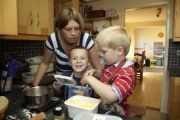Autism
 Descriptions and diagnosis
Descriptions and diagnosis
Descriptions of autism and the narrative around the term continue to change and evolve. In a few short years the description of autism has gone from a devastating lifelong disability to being a part of natural diversity and personal identity to be celebrated. We have seen a shift from predominantly medical approaches involving interventions to target and change autistic features or behaviours, to social approaches, relying more on acceptance, accommodation, and reasonable adjustments.
The diagnostic criteria (DSM and ICD) continue to define autism as a developmental disorder affecting social communication and behaviour. Recent revisions have seen an emphasis on the nature and degree of help or support needed, and the removal of the term Asperger syndrome as a form of autism.
A clinical diagnosis of autism is made based on observed behaviour against agreed criteria, which are periodically reviewed and revised. These include the core features of autism, consisting of the presence of unusual or atypical development, for example, repetitive behaviours, sensory processing differences, and unusual memory, alongside the absence of typical or usual development, affecting the development of speech, conventional social understanding, communication, and behaviour.
The core features of autism are often accompanied by other co-occurring conditions. These may include other neurological, physical, or psychological conditions. A particularly common co -occurring condition for the autistic person concerns extreme anxiety. Whereas the core features of autism are relatively stable and constant over time, co-occurring conditions may fluctuate and may be amenable to intervention or supports designed to improve the wellbeing of the person.
Interventions
We believe the most helpful interventions reflect lived experience and focus on those aspects the autistic person finds problematic or are causing them distress. Working with autistic people, approaches have been developed to address difficulties which impact on wellbeing, such as anxiety or sensory processing, or are related to the improvement of life chances, such as mentoring or employment.
This important, beneficial change in approach has been influenced by a shift in the narrative concerning autism, which has been increasingly impacted by the full involvement of the autistic community itself as equal partners and leaders.
Depending on the nature and degree of expression, and on how autism is perceived and framed, autism is described in the literature as both an ability and a disability. In practical terms this suggests that the welcome recognition and acceptance of autism must not dismiss or downplay the difficulties faced by autistic people but become more aware of the circumstances that cause them so they can be addressed.
Discussion
The framing of autism as part of natural human diversity casts autism as one of several ‘neurodivergent’ conditions. Sometimes described as a ‘neurominority’, autism is seen as a difference to be accepted and accommodated – not a disorder to be treated. Many autistic people regard being autistic as part of their identity and celebrate this, and therefore reject the term 'with autism' as suggestive of something external to them. As with other identities there will be variations and differences. Autism is represented in all races, cultures, and genders, even though historically the focus has been on young white males, from the northern hemisphere. The focus, definitions and descriptions have been somewhat narrow, and it is only in recent times that we have seen any consideration of women and girls, or of other groups or cultures.
Whichever way autism is described, we contend that all autistic people have a right to acceptance, respect and informed support when needed. Such support should be relevant and ethical and subject to proper safeguards and standards concerning implementation and evaluation. This has not always been the case, with many past theories of autism based on dubious or flawed ideas, and with interventions devoted to ‘reversing’, ‘curing’ autism, or ‘fixing’ so called ‘autistic behaviours’. Often delivered via dogmatic, doctrinaire, or unethical or discriminatory methods, we have seen some that are exploitative, hazardous, or harmful, frequently reflecting fads or cultish ideas or even quackery. Most were poorly evaluated. We have even seen examples of autism ‘treatments’ leading to extreme physical harm, including death, and to longer term trauma with implications for lifelong health and wellbeing. Working in partnership with the autistic community has changed the way we think, and what we do. This in turn influences the information we provide and the help we offer.
- Updated
- 07 Jun 2022

